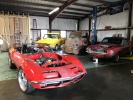I'm having a discussion elsewhere about narrowband readings and I thought I'd copy/paste what I was saying here. I know common internet knowledge is to NOT use narrowband data for tuning, but I strongly disagree. They can absolutely give you valuable data if you know what you're looking at.
Anyway, here's my posts on the subject...
Hey this is a big HEADS UP for you guys that don't have widebands, or have widebands but aren't logging with them...
Look at your narrowbands!!! I know everyone will say "You can't use narrowbands for tuning". Well in case you haven't noticed yet, I'm not everyone. lol. Well guess what, you CAN use narrowbands as a very good indication of WOT mixtures, especially when they're way off. Somebody just sent me a log of some WOT runs, but they didn't have their wideband logging in v3.0 yet. They did have their narrowbands being logged though. At WOT the narrowbands were reading in the very low .800's. That's hella lean! Narrowbands should be reading in the high .900's when WOT fueling is closer to optimum.
Did you mean CAN or CAN'T? I believe you can. I look at narrowband traces in logs all the time.What would you say high 900s equates to lambda wise being optimal?
Do you know you can trust the accuracy of a narrowband , especially one that may have considerable use as it gets further away from 450mv?
Good question on the Lambda relationship. Here's a couple screen shots of a MAJOR fuel pump issue. It should be blatently obvious to see what's happening even for the guys who have never looked at HPT logs. I took a shot at the beginning of the pull and the end so you can see the voltages compared to the Lambda readings. They do end up being a viable indication of mixture, and for a LOT of guys using slow widebands, they react WAY faster so you can see transient issues that you wouldn't be able to see in their widebands.
BTW, look at the fuel pressures. So if ALL you had to go by in this log was the narrowband readings, would you be able to tell there was a major issue? Absolutely. Lemme know if anyone needs anything in these screenshots explained.
[/QUOTE]
If a narrowband is "degraded", it's faulty. If it can't produce up to 1 volt, it's faulty. Obviously a reading from a faulty sensor would be useless. Modern oxygen sensors are extremely reliable and rarely degrade to a point of "working" but not reading correctly. It would either be setting a code or causing closed loop fueling issues if it was that far degraded.I agree they can be an indication that fueling may need to be looked at whether physical or in the tune. What it really does though is just point out the need to get a wideband on it to see what is really going on. I see a lot of degredation in the narrow bands over time which can skew their readings quite a bit.
If it's a properly working narrowband sensor, it's readings ARE usable, repeatable, transferable and valuable. You gotta remember my training and job experience ever since my first class at the GM Training Center in 1983 has depended on my understanding how oxygen sensors operate. (I still remember what the class was about, it was a week long class about the Cadillac Digital Fuel Injection. Pretty cutting edge stuff for '83!) I've been looking at oxygen sensor voltages damn near everyday for 33 years now, it's my job. lol.
My big point here is that MANY guys don't have widebands, or aren't logging them for various reasons. Sure, it would be ideal if you had an ACCURATE wideband in every car, but that's not gonna happen. And I put accurate in caps because I also believe, damn, I KNOW that a large percentage of those guys with widebands are getting inaccurate information anyway. The sensors are either too slow or the offsets aren't set up correctly. The latter is the most common problem and can result in wideband readings that aren't even close to actual exhaust content. If you understand how to read narrowbands, it can, and often does tell you if your wideband is even in the right ballpark in IT'S readings.[/QUOTE]





 Reply With Quote
Reply With Quote





